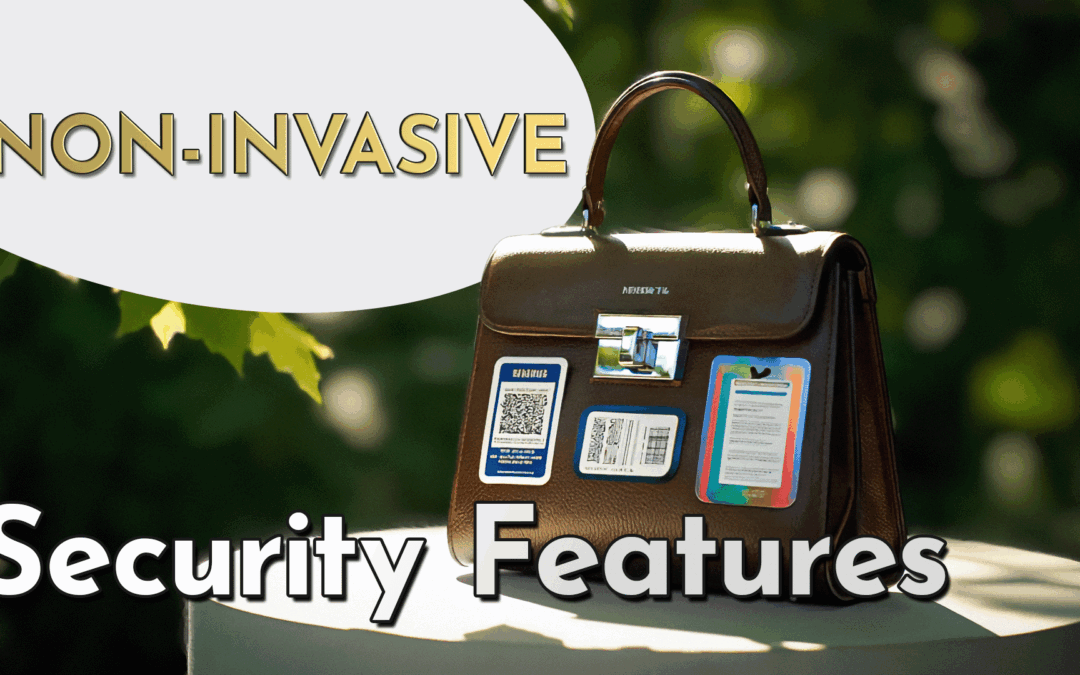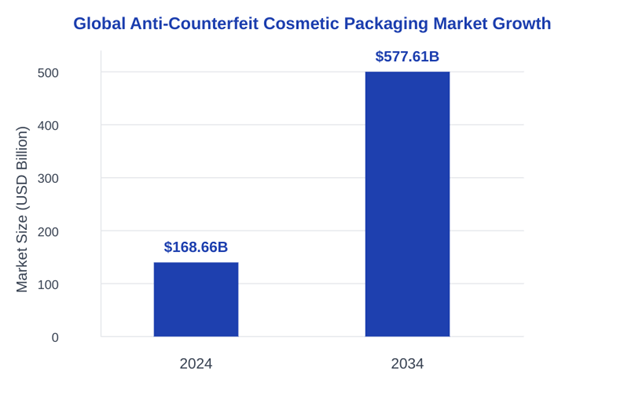Non-invasive brand protection is a cutting-edge approach to fighting counterfeits. It works by embedding invisible security features on the product or its packaging. The human eye can’t see these microscopic features, but they create a unique, tamper-proof signature that’s impossible for counterfeiters to replicate.
Take a traditional anti-counterfeiting method like holograms. All a counterfeiter has to do is create a convincing copy of what they can see. And with today’s technology, that’s becoming easier and cheaper every year.
But how do you copy something you can’t even see?
This is where AlpVision has revolutionized brand protection. We developed several technologies that hide authentication features in plain sight.
With our solutions, you can do what once took expensive equipment and special training at a fraction of the cost.
The Growing Threat of Counterfeiting
Most people ignore the impact counterfeiting has on their lives. It often feels like a distant problem to them, like an issue reserved to luxury brands or street vendors.
The data says otherwise.
Global Trade of counterfeit goods represents 2.5 % of world trade, or USD 461 billion. That’s 461 billion dollars that flow into criminal networks instead of legitimate businesses, deprive governments of tax revenue, and put consumers at risk with potentially dangerous products.
And what’s worse, counterfeiting affects every industry sector and every consumer.
The impact of counterfeiting touches every sector of the global economy.
U.S. Customs and Border Protection’s interception of over 3 million counterfeit health and safety products in 2023 demonstrates the scale of this threat to public safety. The fashion industry has been hit particularly hard, with the European Union’s clothing sector losing an estimated 5.2% of total sales (EUR 12 billion) to counterfeit goods between 2018 and 2021. The cosmetics industry faces similar challenges, with counterfeit products causing losses of 4.7 billion euros in 2020 alone.
These figures show that counterfeiting isn’t just a luxury brand problem, but an ever-growing threat across all industries.
How Legit Companies Are Fighting Back
Companies spend billions in the fight against counterfeiting. For example, the global anti-counterfeit cosmetic packaging market reached USD 168.66 billion in 2024 and is projected to grow to USD 577.61 billion by 2034.
Data source: Precedence Research
However, traditional visible security features like taggants present significant challenges. Not only can counterfeiters study and replicate them, but they also alter product aesthetics, diminishing brand value.
This is why brands are increasingly turning to hidden security solutions. Think of them like an invisible watermark, undetectable to the naked eye yet providing reliable authentication.
These solutions use microscopic patterns naturally created during manufacturing or tiny holes in the varnish layer that can only be detected with specialized tools.
What is Non-Invasive Brand Protection?
Non-invasive brand protection refers to security technologies that authenticate products without altering their appearance or manufacturing process.
Traditional brand protection relied on adding visible elements to the packaging or the product. Banknotes, for example, use holograms, special inks, and watermarks that anyone can see.
While these features worked well in the past, they face two major challenges today:
- Advances in printing technology make them easier to copy
- They alter the product’s appearance, which can diminish brand value
Modern non-invasive solutions take a different approach. They use invisible features that already exist in your product or create microscopic patterns that the human eye can’t detect. This makes authentication both more secure and more elegant than traditional methods.
Think of it like a building’s security system. Old-school security relied on visible deterrents like bars on windows. Modern systems, on the other hand, use invisible sensors and cameras that protect the building without compromising its aesthetics.
Non-invasive brand protection works the same way. It safeguards your products while preserving their design and brand identity.
Main Benefits of Non-Invasive Protection
The beauty of non-invasive protection lies in its three core benefits:
- The security features remain completely invisible to both consumers and counterfeiters
- You won’t have to alter your existing manufacture process to implement it
- These solutions have zero impact on product aesthetics
Brands invest heavily in design and packaging to create a specific look and feel. Non-invasive protection preserves this investment completely, maintaining the premium appearance that customers expect.
Today’s brand owners have access to several types of non-invasive security features. Each solution offers different benefits, and selecting the right one depends on your specific needs.
Among these, AlpVision’s Cryptoglyph and Fingerprint technologies stand out for their innovative approach to invisible product authentication.
AlpVision’s Innovative Non-Invasive Brand Protection Technologies
In the battle against counterfeiting, AlpVision has developed two groundbreaking technologies that provide robust protection while maintaining product aesthetics.
These solutions represent different approaches to non-invasive authentication, each suited to specific product types and manufacturing processes.
Cryptoglyph: Invisible Digital Protection
Cryptoglyph is a digital authentication technology that provides invisible product protection.
It works by introducing an invisible layer of security through microscopic engineering. This patented technology embeds thousands of tiny holes (20-60 microns wide) in the varnish or solid color layer of printed materials.
The result is a secure, unique digital signature that’s impossible to detect with the naked eye. Yet, it’s easily verifiable using a smartphone.
What makes Cryptoglyph particularly effective is that it adds no manufacturing cost and is industrially proven, protecting billions of products each year. The technology can be deployed easily across many printing suppliers since no dedicated hardware or consumable is required.
The technology requires no special inks or additional materials. It works with standard printing processes including:
- Offset
- Flexography
- Rotogravure
- Laser
- Inkjet printing
Cryptoglyph is especially valuable for pharmaceutical packaging, cosmetic products, and any printed materials where authentication is crucial but visible security features would compromise design aesthetics.
With verification taking less than three seconds through a dedicated smartphone app, Cryptoglyph provides a practical solution for real-time authentication anywhere in the supply chain.
Fingerprint: Unique Product Authentication
AlpVision Fingerprint is a unique covert anti-counterfeit solution that tracks and authenticates products.
The technology leverages the intrinsic microscopic surface irregularities found on objects.
Here’s how it works:
- Capture a digital image of the product’s surface structure
- Save this image as a reference in a database
- When authenticating, scan the product with the smartphone application
- The app compares the scanned surface structure to the stored reference
- The system determines if the product is genuine based on this comparison
Like Cryptoglyph, you don’t need to overhaul your current production practice. Even better, it works retroactively.
You can take a reference image from current production channel and one of a product on the market. As long as the mold cavities haven’t been replaced, the system can still authenticate these products.
The technology has proven successful across a wide range of molded and tooled products, including:
- Fashion goods (shoes, watches, jewelry, perfume)
- Automotive parts (lubricants, brake pads)
- Electronic products (circuit breakers)
- Precious metals (gold, silver, platinum, palladium and rhodium ingots or coins)
For physical products manufactured through molding or tooling processes, AlpVision Fingerprint provides a powerful, non-invasive way to ensure authenticity without changing your production workflow.
Advantages of Non-Invasive Brand Protection with AlpVision
When choosing a brand protection solution, manufacturers often worry about production disruption, cost increases, and impact on product aesthetics.
AlpVision’s technologies address these concerns while offering several compelling advantages:
- Invisible: Adds security without changing product appearance
- Seamless: Integrates with existing production processes
- Cost-Effective: No special materials or equipment needed
- Highly Secure: Covert features are extremely difficult to replicate
- Builds Trust: Easy authentication builds consumer trust
- Scalable: Proven to protect billions of products across industries
- Insightful: Provides valuable data through our Brand Monitoring System
These advantages make AlpVision’s solutions particularly attractive for brands seeking robust protection without compromising their existing operations or product appeal. The question then becomes: how do you implement these technologies in your business?
How to Implement Non-Invasive Brand Protection in Your Business
Adding covert protection to your products is simpler than you might think. You won’t need to overhaul your production line or retrain your whole staff.
First, look at your product line. Which items face the highest counterfeiting risk? These should be your priority.
Then choose your technology based on your product type.
If you work with printed materials like packaging or labels, Cryptoglyph is your solution. It adds microscopic holes to your varnish layer during the normal printing process. Your printers won’t need special inks or equipment; they can use offset, flexography, rotogravure, or any other standard printing method.
For molded products, Fingerprint technology leverages your existing productive process. Every mold creates unique microscopic patterns on your product’s surface. We capture these patterns as a reference, turning them into a powerful authentication tool.
Implementation is straightforward. Your suppliers can start using Cryptoglyph right away with their current setup. For Fingerprint, we’ll capture reference images of your products to create authentication baselines.
The final piece is our smartphone app that verifies products in seconds. Anyone in your supply chain can use it, from quality control to retailers, and even consumers.
Conclusion: Future-Proof Your Brand with Non-Invasive Protection
Counterfeiting has been evolving together with authentication techniques. Brands play a game of cat and mouse with counterfeiters: every visible security feature eventually gets copied, forcing companies to develop new ones.
But what if you could break this cycle? What if instead of adding more visible features, you could hide authentication in plain sight?
This is what non-invasive brand protection delivers. Whether through microscopic holes in your varnish layer or unique surface patterns from your molds, you get security that counterfeiters can’t even see, let alone copy.
Ready to protect your brand? Download our whitepaper to learn which technology best fits your needs. We’ll help you compare different solutions and find the perfect match for your products.
Download Our Whitepaper


